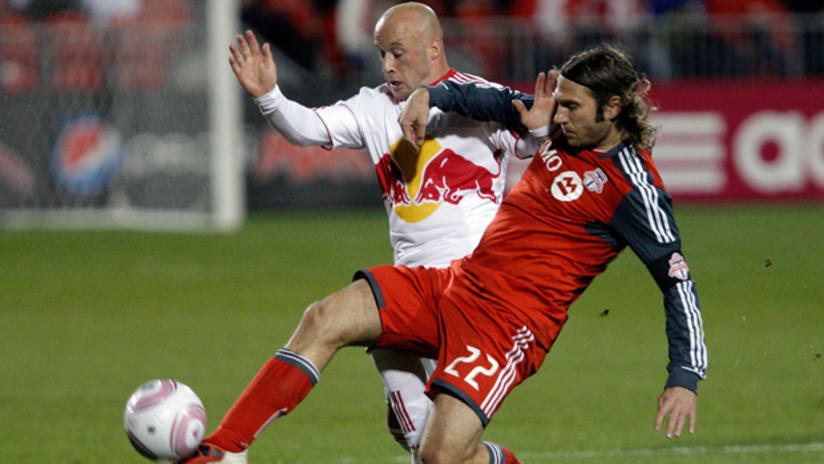We tend to spend disproportionate time on Toronto FC in Talking Tactics. It may seem like an uneven share among 18 MLS sides, especially considering that TFC now reside squarely in “We’ll get ‘em next year” territory, their playoff chase officially over.
But the fact of the matter is that TFC and Dutch boss Aron Winter have been Major League Soccer’s tactical provocateurs in 2011 – probably more tactically daring than any MLS club for some time, in fact. First, they showed us a 4-3-3, a system that’s as fluid and dynamic but as it is controversial among armchair tacticians who insist that it’s ill-fitted for MLS.
Saturday against the New York Red Bulls, Winter seeded yet another less-than-conventional arrangement, a 3-4-3 that’s made appearances here and there around BMO Field this year.
Toronto’s primary gamble was taking their top available ball handler, German veteran Torsten Frings, and moving him further back in the formation. Usually a holding midfielder (where he helped Germany to a third-place World Cup 2006 finish), Frings was a sweeper behind center backs Ty Harden and Andy Iro. While he couldn’t fulfill his usual linking duties, Frings was tasked with initiating most of the attacks, a ploy that created orderly, dependable movement out of the back.
From there, a critical element in TFC’s ability to manufacture a few chances was Ryan Johnson’s astute positioning as the left-sided forward.
Typically, a Dutch-flavored arrangement of three forwards means one centrally stationed target presence (Danny Koevermans for TFC) actively moving forward and backward to seek linking opportunities near midfield or chances near goal. Two wingers supply the balancing width, keeping defenders stretched across the field while probing for one-on-one opportunities to run at the back line.
All that hinges on three centrally stationed midfielders, no matter which way the “V” is shaped. In a 4-3-3, they stay central while the wingers find the touchlines. The width is created differently in a 3-4-3. Midfielder Matt Stinson on the right and up-and-coming defender Ashtone Morgan on the left relieved TFC’s midfield of the bulk of their touchline duties. Meanwhile, Terry Dunfield (who was highly productive in his role Saturday) held defensively iin the center while Eric Avila played slightly ahead of him.
That approach left Johnson (normally positioned as a winger) free to poach inside and exploit a yawning gap, one that developed as this less conventional plan seemed to bamboozle the Red Bulls defence. Johnson was almost always available in an area inside left, somewhere between the visitors’ back line and their midfield. Dane Richards, along the Red Bull’s right, struggled to sort out his defensive responsibilities, unsure of whether to track Morgan out wide or push inside to assist midfielder Rafa Marquez and the Red Bulls center backs in dealing with Johnson.
This is where a 3-4-3 (or 4-3-3, or 3-5-2 or any less conventional formation) always has a chance to put the better-understood 4-4-2 in a bind. New York seemed clearly less comfortable handling TFC’s unfamiliar setup.
Toronto’s 3-4-3 created some defensive confusion and a few chances, although not a bundle of them. But offensive punch is only half of any tactical target, of course, and Winter’s formation du jour certainly had a valuable effect going the other direction.
Richards may not always make the best choices in the attacking third, but he’s habitually dangerous with the ball, consistently in demand of defensive attention. Not so on Saturday – all that head-scratching defensively seemed to tame his attacking initiative.
The Reds’ formation also proved a perfect antidote for Thierry Henry’s tendency to drift into midfield. Iro and Harden locked on early and aggressively, often following Henry high up the field. That should have left big gaps behind the TFC marking backs – but it didn’t.
Why not? Because neither Marquez nor fellow Red Bulls center midfielder Teemu Tainio had the willingness or the energy to push into those areas, to threaten a numbers-up situation and force Avila to track and play more defence. Neither did Richards insert himself quickly enough into the channel behind Iro (TFC’s left-sided marker). That would have forced Iro to make choices about when and where to drift wide to help Morgan, potentially leaving the center exposed.
A little tactical adjustment would have gone a long way for New York. For instance, Morgan, in contrast to Richards, had a good feel for his defensive duties. He needed to stay wide and track the Red Bull’s speedy flanker, which he did wonderfully. Perhaps Richards could have repositioned himself inside, forcing Morgan and Iro to make choices about whom to track.
Re-positioning Richards would have required some defensive adjustment, of course, probably having Marquez slide out closer to the touch line defensively. But that’s what these games are all about. They adjust, you adjust to the adjustments, etc.
As for TFC, you could argue that home team tactics should be arranged to create on offence, not to stifle on defence. But the 3-4-3 isn’t some crackpot scheme to frustrate another team’s talent; the world’s best team just made a similar switch, albeit mostly because Barcelona’s first-choice center backs, Gerard Pique and Carles Puyol, are injured.
And TFC made their system work for 87 minutes against a dangerous team. It took a special moment from Henry to keep Winter’s team (and the new formation) from taking all three points in what ended up a 1-1 draw.

